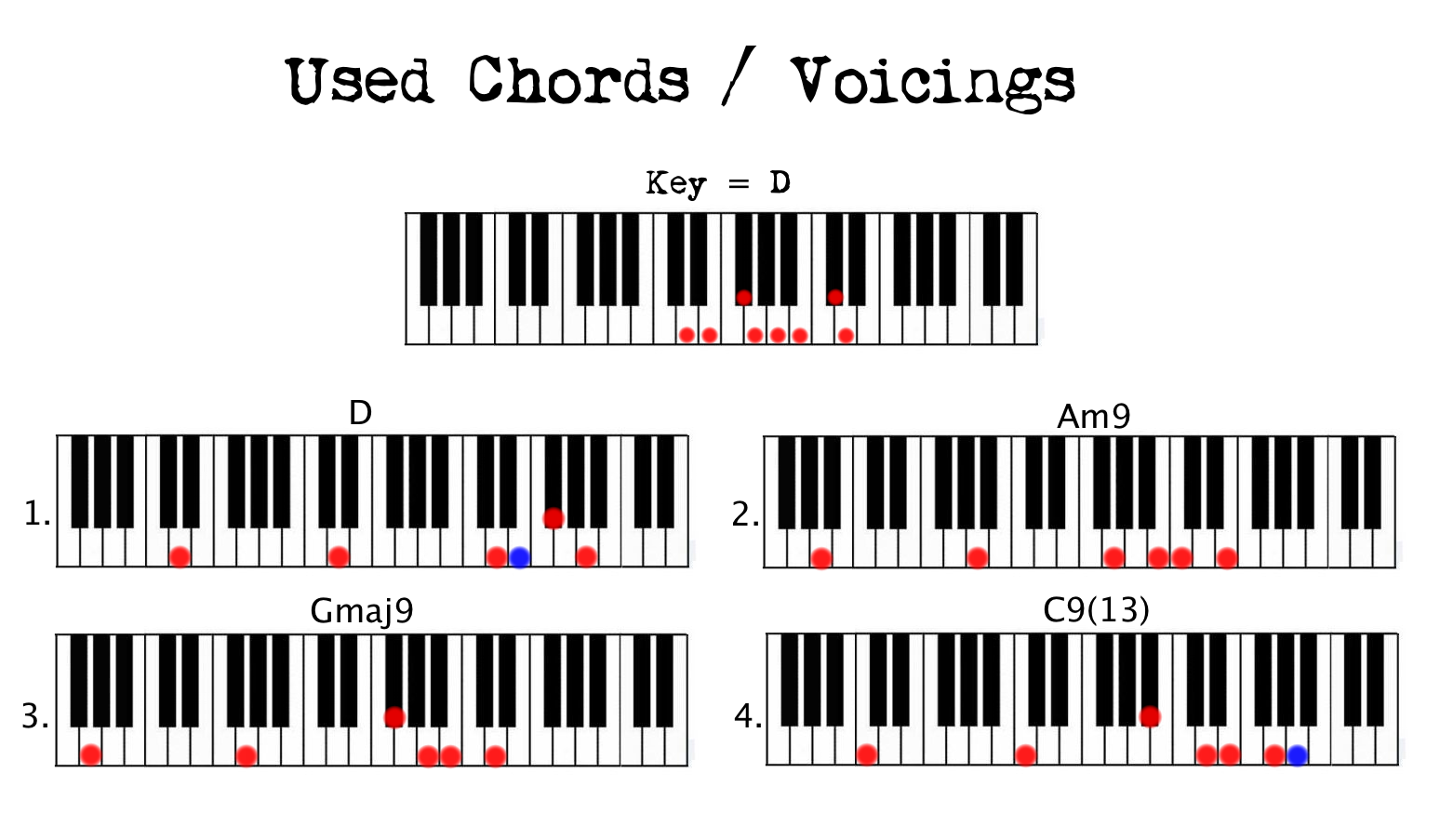Hi all!
How’s everybody doing? I must say that I’m a little disappointed and also scared, for I received not even one new-years-piano-goal-resolution, in the comments of last weeks post!
Although a few of the emails I received from many of you, did contain a few (which I already told you, I cannot post in the comments myself, it has to be you! please comment in stead of mail!), most of the emails also didn’t include any!
Don’t you guys wanna learn and / or get better?? 😉
This week we’ll dive into extension notes again. At the end of the text of this lesson, I added a little bonus for all of you newsletter subscribers and members, so read on!
Please leave a comment with your answer to the challenge as described at the end of the post.

Who needs titles anyway?
D’angelo is a gifted songwriter, a true ‘soul-man’, one hell of a singer and on top of all that, also a great piano player. Truly a virtuoso musician.
This smooth song is a great exercise for practicing heavy voiced chords (with extension notes up to 13’s), groove and timing, as well as practicing ‘messing around’ with inversions and different ways of spreading the notes of a chord over the piano. Practicing creativity, so to speak.
As I also say in the video, this is one of those ‘freestyle’ songs, that also D’angelo himself, doesn’t really have a fixed piano piece for. He just knows which harmonies he want to play when (e.g. he knows the chords to the song) and uses his knowledge of chords and inversions, mixed with patterns, to create a ‘non-fixed’ piano piece, on the spot, that can (or even probably: will) thus not be exactly the same every different time he plays it.
A great example of exactly what I’m trying to teach y’all here at Piano Couture: know your chords, know your patterns, add your creativity and feeling, mix ‘em all together and PLAY!
Apart from advising you to just follow the lesson in the video, I’ll quickly dive into the chords used (and their extension notes) and add some tips and explanation here:
The first chord ‘D’ is pretty straightforward. No extensions here yet, although a ‘sus2′ (‘9′) (the note ‘e’) is used as a flam-note (quickly playing the ‘e’ immediately ‘resolving’ to an f#), when the root position of the chord is played.
As I indicate in the video, you can voice this chord however you like. You’ll see me play a few different version myself throughout the video. Picture above indicates a couple of optional notes that you can use in the voicing.
While the harmony is still ‘in D’ you’re going to play a simple melody, walking over notes of the key (‘d’) from the ‘f#’ to the ‘a’ with both your left and your right hand, to ‘land’ on the next chord, Am9.
So there’s our first ‘heavy chord’. A minor with an added ‘7’ (‘g’) and ‘9’ (‘b’).
@ 2:45 I show you where this voicing comes from, by going back to the root position (‘a’, ‘c’, ‘e’), ten adding the 7, the 9 and then inverting the chord to this particular voicing.
After that I also quickly show you two more inversions, which can also be very well used! Whatever you feel like, that’s the beauty here. (as it almost always is in Pop-Piano).
Another heavy one, Gmaj9, also a 7 and a 9, I also indicate in the video where they come from and how to invert to this voicing. Again, feel free to use any other inversion / voicing as you please.
While still in this harmony, the following melody (picture below) is played. Optional is to add an ‘a’ as a top note, above the actual melody note on the first note: ‘f#’ in your right hand and even a ‘d’ below this melody note (this is called ‘harmonising’ the melody). You’ll see me explain and show you to add the ‘a’ in the tutorial, but I did also use the ‘d’ in the ‘end result’ at the start a few times.
See how doing this, actually comes down to using the same voicing and technique (‘flaming’ from ‘e’ to ‘f#’) as with the first chord D? So actually you’re playing a D chord with your right hand like this?
This melody bit end on (‘falls’ on) the next chord: C9.
In this picture I also indicated a couple of different notes that you can use to make different voicings to your likings.
The ’13’ (‘a’) is added later, on the first beat of the second measure that the harmony is C(9).
Well, then you’re there!
Actually not quite. These chords are played during both the verse and the chorus, but there is still the pre-chorus (‘You’ve already got me, right where you want me baby, I just wanna be your man’).
This part is not explained in the video, but it is my extra special gift to all you followers here on the site!
After the part ‘Won’t you come closer to me baby’ which is on Gmaj9 in the 4th round (so the 4th time the Gmaj9 is played) you don’t go to Cmaj9, but to these next chords.
Hold the first 2 chords (F#m7 and B7) for 1 measure (3 beats) each and feel free to spice the chords up to your own will by adding a ‘9’ here too! (optional).
The second 2 chords (Em9 and Asus) both last 2 measures (6 beats) each.
If you add that, you can play verse – pre-chorus – chorus – verse etc.!
Alright so that’s it for now, anybody interested in the bridge? If so, leave a comment and I’ll email it straight to ya!
Challenge for this week: of course to learn the song and play it! 🙂
But apart from that: I told you to ‘feel free to spice up’ the first two chords of the pre-chorus F#m7 and B7, by adding a ‘9’ to those chords. Which notes would that be?
Tell me in the comments! I dare you!
For now, Cheers and happy playing!
Coen.
Questions? Remarks? Show me how you play this song! Please leave a comment below!
I’m also very curious which tutorial you’d like to see next!


I loved the D'Angelo Untitled piano lesson. Please send me a copy of the Bridge to this song. The chord progressions were awesome. By listening to the original song I could not distinguish the piano chords because they were eclipsed by the other instruments playing. Thank you for your tutorial.
sincerely,
Big
Hi Big,
Thanks for your comment, glad you liked it! I don't have sheets to the bridge unfortunately.
Cheers, Coen.
I've figured out mooost of the song by ear, the bridge is a little tricky. Definitely hearing that F# chord in there. If you could send me the bridge that'd be amazing! 1 Love.
Chords for the bridge are: F#m7(9), B7(9), Em9, Asus. Cheers! Coen
Coen
Your youtube video tutorials are just what I need, thank you! As a drummer teaching my self piano, I find them really helpful! Thank you for including the chord symbols and breaking them down and explaining what they are and their exact voicing etc!
I found you when I was looking for a tutorial for D'angelo's 'Spanish Joint'. D'angelo is my biggest inspiration and when I heard his acoustic demo version, I HAD to know how to play it. Knowing the theory will also really help when I come to rehearse it with a band.
Can you please do a tutorial of Spanish Joint? Preferably, the Acoustic Demo version that is on Youtube, I'd really appreciate it, and its KILLER, i'm sure you'll love it, if you have';t heard it already, which I'm sure you have!
All the best bro!
James
Hi James,
Thanks so much for your comment! Yes I know that one and it indeed is more than awesome, to say the least. I figured out how to play it quite a while ago, will check if I still know how to play it and definitely take your request into serious consideration.
Glad I could be of help so far! Great to read you are enjoying my stuff :).
Cheers
Hey man, I really enjoyed this lesson. D'Angelo is one of my favorite artists and this song is probably one of my favorite nostalgia songs to play from the heyday of R-N-B. This is the best tutorial that I have found on this song, hands down. I was interested in knowing if you could email me the bridge if it wouldn't be too much trouble. Thanks man for the work you are doing in helping so many people understand music a little bit better.
love this, used this to really nail the song. so much appreciated!
Thanks so much for your comment TK! Glad you liked it.
Cheers, Coen.